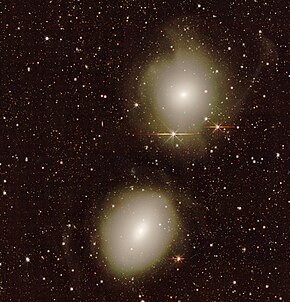NGC 1549 is an elliptical galaxy located in the constellation Dorado. It is located at a distance of about 50 million light years from Earth, which, given its apparent dimensions, means that NGC 1549 is about 75,000 light years across. NGC 1549 was discovered by John Herschel on 6 December 1835 and may have been observed by James Dunlop in 1826.[2] It is a member of the Dorado Group.
| NGC 1549 | |
|---|---|
 NGC 1549 (top) and NGC 1553 (bottom) by legacy surveys | |
| Observation data (J2000 epoch) | |
| Constellation | Dorado |
| Right ascension | 04h 15m 45.1s[1] |
| Declination | −55° 35′ 32″[1] |
| Redshift | 0.004190 ± 0.000040 [1] |
| Heliocentric radial velocity | 1,256 ± 12 km/s[1] |
| Distance | 51.2 ± 14 Mly (15.7 ± 4.4 Mpc)[1] |
| Group or cluster | Dorado Group |
| Apparent magnitude (V) | 9.6 |
| Characteristics | |
| Type | E0-1 [1] |
| Apparent size (V) | 4.9′ × 4.1′[1] |
| Other designations | |
| ESO 157-G16, AM 0414-554, PGC 14757[1] | |
In the centre of NGC 1549 is expected to lie a supermassive black hole, whose mass is estimated to be between 390 and 810 million (108.76+0.15
−0.17) M☉ based on the Sérsic index of the galaxy.[3] No polycyclic aromatic hydrocarbons (PAHs) emission, an indicator for the presence of interstellar dust, was detected by the Infrared Spectrograph onboard Spitzer Space Telescope.[4] NGC 1549 has been found to emit X-rays, with its total flux exceeding 2×1040 ergs s–1 for the 0.3–5 keV band.[5] A total number of 150 globular clusters are estimated to exist in NGC 1549, a number low compared to similar size galaxies.[6] The outer isophotes of the galaxy appear twisted and feature faint shells.[7]
NGC 1549 forms an interacting pair with the lenticular galaxy NGC 1553, which lies 12 arcminutes to the south.[8] It is the largest elliptical galaxy in a moderate size galaxy group known as the Dorado Group.[9]
References
edit- ^ a b c d e f g h "NASA/IPAC Extragalactic Database". Results for NGC 1549. Retrieved 2016-01-18.
- ^ Seligman, Courtney. "NGC 1549 (= PGC 14757)". Celestial Atlas. Retrieved 19 November 2018.
- ^ Mutlu-Pakdil, Burçin; Seigar, Marc S.; Davis, Benjamin L. (17 October 2016). "The local black hole mass function derived from the MBH-P and the MBH-n relations". The Astrophysical Journal. 830 (2): 117. arXiv:1607.07325. Bibcode:2016ApJ...830..117M. doi:10.3847/0004-637X/830/2/117. S2CID 118586684.
- ^ Kaneda, H.; Onaka, T.; Sakon, I.; Kitayama, T.; Okada, Y.; Suzuki, T. (September 2008). "Properties of Polycyclic Aromatic Hydrocarbons in Local Elliptical Galaxies Revealed by the Infrared Spectrograph on Spitzer". The Astrophysical Journal. 684 (1): 270–281. arXiv:0805.3257. Bibcode:2008ApJ...684..270K. doi:10.1086/590243. S2CID 14065147.
- ^ Diehl, Steven; Statler, Thomas S. (10 October 2007). "The Hot Interstellar Medium of Normal Elliptical Galaxies. I. A Chandra Gas Gallery and Comparison of X-Ray and Optical Morphology". The Astrophysical Journal. 668 (1): 150–167. arXiv:astro-ph/0606215. Bibcode:2007ApJ...668..150D. doi:10.1086/521009. S2CID 14507041.
- ^ Bridges, Terry J.; Hanes, David A. (April 1990). "Globular clusters in the interacting galaxies NGC 1549 and NGC 1553". The Astronomical Journal. 99: 1100. Bibcode:1990AJ.....99.1100B. doi:10.1086/115399.
- ^ Franx, Marijn; Illingworth, Garth; Heckman, Timothy (August 1989). "Multicolor surface photometry of 17 ellipticals" (PDF). The Astronomical Journal. 98: 538. Bibcode:1989AJ.....98..538F. doi:10.1086/115157. hdl:1887/6554.
- ^ de Vaucouleurs, G.; de Vaucouleurs, A.; Corwin, J. R. (1976). "Second reference catalogue of bright galaxies". Second Reference Catalogue of Bright Galaxies. 1976. Bibcode:1976RC2...C......0D.
- ^ Kilborn, V. A.; Koribalski, B. S.; Forbes, D. A.; Barnes, D. G.; Musgrave, R. C. (1 January 2005). "A wide-field HI study of the NGC 1566 group". Monthly Notices of the Royal Astronomical Society. 356 (1): 77–88. arXiv:astro-ph/0409743. Bibcode:2005MNRAS.356...77K. doi:10.1111/j.1365-2966.2004.08450.x.
External links
edit- Media related to NGC 1549 at Wikimedia Commons
- NGC 1549 on WikiSky: DSS2, SDSS, GALEX, IRAS, Hydrogen α, X-Ray, Astrophoto, Sky Map, Articles and images
- NGC 1549 on SIMBAD